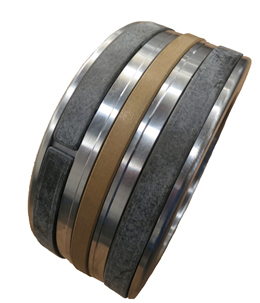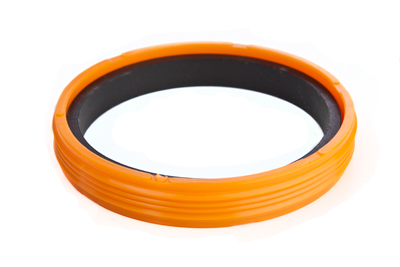Top Quality Seals - North American
 When it comes to OEM engineered designs, Hallite is our supplier of choice for high quality seals. Hallite is a leading manufacturer of high performance seals and sealing solutions for the global fluid power industry.
When it comes to OEM engineered designs, Hallite is our supplier of choice for high quality seals. Hallite is a leading manufacturer of high performance seals and sealing solutions for the global fluid power industry.
Hydraulic cylinder seals must be:
- Low friction
- Resistant to water, oil and chemicals
- Have the ability to withstand high pressures
- Weather proof - function in hot and cold conditions
Eagle can specify the right choice for your application


Storage of Seals
 Most polymeric items including vulcanized rubber and other elastomers
tend to change their properties during storage and may become
unserviceable. This may be due to hardening, softening, cracking,
crazing or other degradation and may be the result of oxygen,
ozone, light, heat and/or humidity.
Most polymeric items including vulcanized rubber and other elastomers
tend to change their properties during storage and may become
unserviceable. This may be due to hardening, softening, cracking,
crazing or other degradation and may be the result of oxygen,
ozone, light, heat and/or humidity. The following recommendations indicate the most suitable conditions for storing elastomeric items, whether as a single item or composite product.
-
1
TEMPERATURE
Storage temperatures should not exceed 50oc. Low temperatures are not permanently harmful provided the rubber items are handled carefully and not distorted. When taken from low temperatures items should be raised to approximately 30oc before they are used. -
2
HUMIDITY
Optimum humidity is about 65% in a draft-free atmosphere. -
3
LIGHT
Protection from direct sunlight and strong artificial light with a high ultraviolet content is important. Unless packed in opaque containers, it is advisable to cover windows with red or orange screens or coatings. -
4
OXYGEN & OZONE
Elastomeric items should be protected from circulating air wherever possible. As ozone is particularly harmful to rubber, storage rooms should be free from equipment that may give rise to electric sparks or discharge. Wrapping, storage in airtight containers or other suitable means should be used for vulcanised rubber items. -
5
DEFORMATION
Where possible, rubber items should be stored in a relaxed position, free from tension or compression. Laying the item flat and avoiding suspension or crushing keeps it free from strain and minimizes deformation. -
6
CONTACT WITH LIQUID AND SEMI-SOLID MATERIAL
Contact with liquids and semi-solid materials, particularly solvents, such as oils or greases should be avoided unless so packed by the manufacturer. -
7
CONTACT WITH METALS
Metals such as manganese, iron and copper, or copper alloys can have a harmful effect on rubber. A layer of paper, polyethylene or cellophane will keep these separated. -
8
CONTACT WITH NON-METALS
Contact with other rubbers or creosotes should be avoided. -
9
STOCK ROTATION
Elastomers should be stored for as short a period as possible, and strict stock rotation should be practiced. -
10
CLEANING
Organic solvents such as trichloroethylene, carbon tetrachloride and petroleum are the most harmful agents. Soap and water and methylated spirits are the least harmful, and all parts should be dried at room temperature before use. -
11
SHELF LIFE
The table shows the storage life of seal components made from the more common materials under ideal conditions. Storing under less than ideal conditions will reduce the life.
Careful inspection of the following should be made before installation after storage:
A) Mechanical damage
B) Permanent distortion
C) Cracks or surface crazing
D) Tackiness or surface softening/hardening
*Thin components (less than 1.6mm {1/16in}) tend to be more critically affected.
Use and Fitting of Seals

Our quality control methods for material and manufacturing processes ensure that all seals leaving our factories are in a condition capable of giving a long and reliable service life.
We have found from many years experience, that premature seal failure can be avoided if the following recommendations are considered at the design manufacturing stage of the cylinder:
- 1. Specify piston and gland bearings which are adequately proportioned to support the cylinder loads. As a result of mounting misalignments and / or the working action of the cylinder, piston and gland bearings will be subjected to side-loading, causing damage to the rod or the tube surface and hence the seal, if the bearings are inadequate.
- 2. Ensure that seals are stored distortion free in a cool, dry and dark place prior to fitting.
- 3. Check that the seal housing is free from damage likely to harm the seal. Remove all sharp edges and burrs from metal parts, paying particular attention to ports, grooves and threads over or through which the seal passes during assembly.
- 4. Clean all seal housing areas, ensuring that all metallic particles and other contaminants have been removed. Check that other surfaces adjacent to the passage of the seal on fitting are also free of dirt, swarf or other contaminants. Check that both static and dynamic housing surface finishes meet specifications.
- 5. Where the difference between a thread diameter over which the seal must pass and the seal diameter is small, use some form of protection over the thread, such as a fitting sleeve made of hard plastic.
- 6. Check that the seal is of the correct type, part number and size, and that the specified material is correct.
- 7. Lubricate all seals and metal components liberally with clean operating fluid or a compatible grease prior to assembly. Please note that silicone grease should not be used in normal hydraulic applications.
- 8. Where seals fitted to sub-assemblies, such as pistons, are awaiting further fitting operations, ensure that the seals are not subjected to any misaligned or localized loading which will cause local deformation. Ensure that sub-assemblies remain clean.
- 9. Ensure that the installation tool being used for inserting the seal is completely smooth and free from any nicks or burrs. When using seal installation tools; ensure that the metal surfaces adjacent to the seal are not damaged.
- 10. Flush the hydraulic system thoroughly before connecting the cylinder to it. Ensure that the contamination levels are controlled and within the guidelines of ISO 4406

Surface Roughness
Surface roughness has a very important influence on the life and leakage performance of a reciprocating sealing system.

Definitions
Many parameters can be used to describe surface finishes and these are explained in ISO 4287 and ISO 4288. Those in most common use in the fluid power industry include:
Ra, which is defined as the arithmetical mean deviation of the assessed profile. The inch equivalent parameter is CLA (centre line average). A surface finish of 0.4 mm Ra is exactly equivalent to 16 uin CLA.
Rt, which is the total height of the profile. There is no mathematical relationship between Ra and Rt.
Rq, which is the root mean square deviation of the assessed profile. The equivalent term in inches is RMS (Root Mean Square). The Rq (RMS) of a surface is approximately 10% greater than the Ra (CLA) value.
The surface roughness parameters given above do not give any indication of the sharpness of the surface. The peaks of the profile should be well rounded as sharp surface finishes can lead to rapid seal wear.
Dynamic surface finishes
Piston rods are generally hard chrome plated. The hardness should be at least 67 Rockwell C (900 HV/10). This gives an excellent tribological surface and provided the rods are produced by an established supplier within a surface finish range of 0.1 to 0.3 mm Ra (4-12 min CLA) no major problem should ensue, although the optimum surface finish may well depend on the seal material.
Bore surface finishes can be more problematic. The typical methods of obtaining a bore finish are summarized in the figure below. Drawn over mandrel (DOM) tubing, as is, can be adequate, or a potential disaster depending on the actual surface texture achieved and the application. Increasing use is being made of Special Smooth Inside Diameter (SSID) DOM tubing, but in certain circumstances, mainly when the seal is being driven into the pressure, it can lead to wear of the seal through flow erosion. Such DOM tubing requires careful specification. The consistency of roller burnished or honed tube is to be preferred. Skived and roller burnished tubing is very smooth (less than 0.1 mm Ra) (4 min CLA) and may be too smooth for rubber sealing elements in some applications. True honed tube, produced between (0.1 and 0.4 mm Ra) (4-16 min CLA) is the most expensive, but has the best finish.
Static surface finishes
The static sealing surface must not be ignored in the control of leakage. Generally, these are fine turned and should be free from chatter marks.
